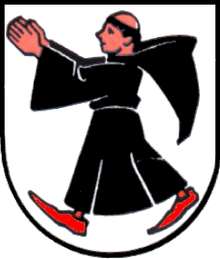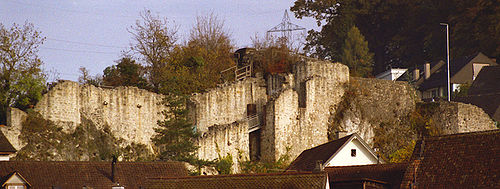- Münch (family lineage)
-
The history of the dynasty of the family Münch unfolded within a period of about three hundred years, between 1200 and 1500 AD. During this time the Münchs were one of the most influential family lineages in Basel.[1]
Contents
Official seal of genital
The original family coat of arms was an upright striding guenon. As of the year 1232, when the Münchs were awarded their knighthood, the crest showed a black clothed with hanging hood, bald headed, with hands folded together in prayer, red shoed monk walking from right to left in front of a white background. The emblem is an equivalent of the modern day official coat of arms of the Municipality Münchenstein.
The name arising
The name Münch first appeared in an official document from the year 1185. Thereafter Hugo Monachus I. was mentioned repeatedly in official documents or in public records, alternatively he was named as "Hugo cognomento", "Hugo cognomine Monachus" or "Hugo Monachus".
The Münchs rose to commissionaires of the bishop of Basel. During this period the bishops mentors and consultants were a privileged society. The first knight (cavalier) Münch was mentioned in 1232 and he lived auf Burg, one of the most exclusive and aristocratic areas in the city, near the Basel Münster.
Family branches
The family divided into various branches. Hugo Monachus I. was the ancestor of the Münch clan. The family Münch von Münchenstein originated from his first son Hugo II. Soon after, the family names Münch von Münchsberg and Münch von Büren/Sterenfels derived from this branch of the lineage. The family names Münchs von Landskron and Münch von Stettenberg/Alsace derived from the second son Konrad II.
Within the various sectors of the family, those from Münchenstein were the most prosperous and in Basel and the surrounding areas they won on importance and significance. But Konrad II. was the first renowned Münch. Between 1221 and 1239 he officiated as head of the bishops court. During this period the Münchs became richer and more powerful and in 1258 the knighted Konrad III. Münch von Münchsberg was named privy counsellor.
During the middle of the 13th century the Münchs acquired their new and extensive residence in the city centre and they named it Münchhof. This was the birth place of the controversial bishop of Basel Hartung Münch (*1265, 25.10.1332). Around 1267 Heinrich I. Münch, the father of Hartung Münch, was documented as the Mayor of Basel (Mayor from the Latin māior, meaning greater).
The Münchs from Stettenberg/Alsace died out soon after 1300 and the branch Münch von Münchsberg in the year 1356.
Ancestral seat
Exactly how the Münchs attained the village of Kekingen (later Geckingen) during the second half of the 13th century is unknown. At this time Geckingen belonged to the cathedral chapter Basel. Around the year 1260 the up-rising cavalier family Münch acquired the village on the hillside adjacent to the river Birs and established their estate there. The exact date of the construction of Münchenstein Castle remains unclear, but most likely building began in the time between 1260 and 1270.
The founder of the castle was Hugo III. Münch, as was mentioned in diverse public records around 1270 [2][3]. The Münchs named the castle on the rock (Stein) after themselves and the cavalier family Münch named themselves henceforth Münch von Münchenstein. Later Hugo IV. Münch von Münchenstein expanded the castle and a built a ring wall around the village. After 1279 the village Geckingen was called Münchenstein. The Münchs could not keep the village and castle for long as their own Property. During 1280 ownership transferred to the Graf von Pfirt, who then lent it to the Münchs in fief.
Expansion
The dynasty expanded further, but the various branches separated and, in time, each family followed its own politics. The Münchs acquired further territories and bought and/or built additional castles. The main influence in this expansion was probably Konrad VIII. (1324–1378), son of Hartmann I. Münch von Münchenstein (who died in 1334). Konrad VIII (called "Hape") married Katharina the hereditary daughter from Löwenburg in 1340. Katharina Münch von Münchenstein-Löwenberg died in 1371 and Konrad VIII inherited governance of Muttenz and the three fortresses in the district Wartenburg. The inherited estate of the Löwenburgs was an advantage to the Münchs von Münchenstein.
New branches
The family branches expanded and grew in number. The families Münch von Münchenstein-Löwenberg and Münch von Münchenstein-Eptingen were founded as the dynasty expanded towards the north.
Properties
The family clan were owners of the following properties, stately homes and castles: Münchhof in the centre of Basel, Münchenstein Castle and the village of Münchenstein, the castle in Münchsberg, the castle in Landskron, the castle Angenstein above Duggingen, as well as the properties and castles Vordere- and Mittlere Wartenberg and the village of Muttenz.
Bishops and clergy
Throughout the family lineage, the Münchs were always well represented in the church or church matters and public affairs. There were always respected clergy, priests and provosts that carried the name Münch. Some of them even rose and became bishops:
- Hartung Münch (born 1265; † 25. October 1332) was bishop of Basel from 1325 to 1328.
- Konrad Münch von Landskron, bishop of Basel from 1393 to 1394
- Johann Münch von Landskron, bishop of Lausanne from 1393 to 1405
- Hartmann III. Münch von Löwenberg, bishop of Basel from 1418 to 1423
Decline
During the 15th century the Münchs prosperity started to deteriorate. This progressed as the bishops authorities weakened and the significance of the Roman Catholic Diocese of Basel decreased. The Münchs decline was also due to wrong political decisions, especially in periods of conflicts. They quickly got poorer and lost influence to the benefit of the new upper class society.
Jerg Münch von Büren/Sterenfels died in 1449, he was the final offspring in this branch of the family.
When Johann IX. Münch died in 1460, as last family member of the Münchs in Landskron, the family branch in Alsace disappeared completely. His brother Burkhard VII. Münch was probably the most renowned of the Münchs from Landskron. Being a Habsburg faithful, he rode as cavalier 1444 with Dauphin Louis XI and Jean V. de Bueil doing duty as translator and guide for the Armagnacs. The Battle of St. Jakob an der Birs was fought on 26 August 1444, this was a battle within the Old Zürich War. During the battle the Swiss pikemen suffered heavy casualties and were virtually wiped out by the Armagnac forces. Following the bloodbath, Burkhard VII. rode across the slaughter field with raised visor and was sarcastically mocking the Swiss band of soldiers, as one of the dying pikemen threw a stone into his face. Burkhard VII. died from his wounds three days later. In Switzerland Burkhard VII. has acquired dubious celebrity as one of the darkest men in Swiss history, because his statement was: "Ich siche in ein rossegarten, den min fordren geret hand vor hunderd jar" (I feel as though I am riding through a garden of roses that my ancestors planted 100 years ago). According to the legend the answer that accompanied the stone was: "Friss eine der Rosen!" (Eat one of your roses).
The last branch of the family, Münch von Münchenstein-Löwenberg, died out in 1795.
Literature
- Münchenstein Heimatkunde. Verlag des Kantons Basel-Landschaft, Liestal 1995, ISBN 978-3-85673-522-7.
- Doris Huggel: "Die Münch on Münchenstein - Aufstieg und Niedergang eines Geschlechts", Kulturkommission der Bürgergemeinde Münchenstein 1999.
- Geschichte der Landschaft Basel und des Kantons Basellandschaft. Band 1. Liestal 1932.
- Heimatgeschichtliches Lesebuch von Basel-Stadt; Basel 1942
- Werner Meyer: Burgen von A bis Z, Burgenlexikon der Regio, Basel 1981
- Werner Meyer: "Münchenstein vom Mittelalter bis ins 17. Jahrhundert, in: Münchenstein Heimatkunde. Band 1. Liestal 1995, Seiten 127 bis 143.
External links
- Altbasel.ch Die Münch im mittelalterlichen Basel (in German)
- Online-Heimatkunde Muttenz The Münchs from Münchenstein and the village of Muttenz (in German)
References
- ^ Die Münch im mittelalterlichen Basel (in German)
- ^ Münchenstein Hompepage (in German)
- ^ Historisches Lexikon der Schweiz Münchenstein (in German)
Categories:- People from Basel-Stadt
- Münchenstein
- History of Switzerland
Wikimedia Foundation. 2010.


